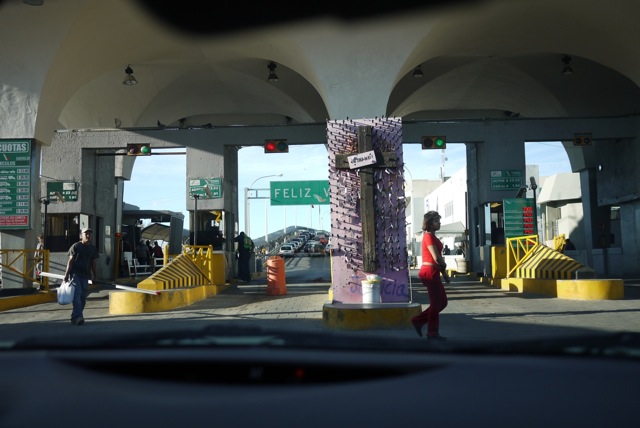EL PASO – It had been a year since I’d last visited Juarez, considered the most dangerous city in the world because of unrelenting drug violence. After crossing the international bridge from EL Paso, I drove into a city under siege, past armed Mexican soldiers and army trucks lining the principal avenue leading to Juarez’s once-bustling central business district.
Later at lunch, at Barrigas restaurant, a friend very much in the know shrugged and put down his fork as he explained, “The city government thought a strong military presence in this area would bring the businesses back,” he said, matter-of-factly.
“And?” I asked.
“It hasn’t worked,” he said, flashing an ironic smile and returning to his shrimp and steak.

View from our car approaching the Paso del Norte Bridge on the way back to El Paso from Juarez. (David Smith-Soto/Borderzine.com)
While he and the other friends my husband and I had lunch with last week seemed unfazed by this in-your-face show of military force on Juarez streets, the sight of so many soldiers with BIG guns left me feeling uneasy, queasy and anxious about the future of a once booming border city and important gateway to the U.S.
When I saw the soldiers strolling along with their M-16’s, a sign I’d seen on a wall in El Paso flashed across my mind like a news ticker on a TV screen: “Warez,” said the block-letter sign, a reference to Mexico’s ongoing drug war, a battle many politicians insist is not a war or even an insurgency, as Secretary of State Hilary Clinton has called it in public.
Juarez/Warez: Why quibble? The situation is pretty bad, regardless of what words you use to describe it. The numbers speak volumes: 53 slain in 72 hours during our recent weekend visit; 300 so far this year; nearly 3000 dead in 2010, with some experts predicting 5000 dead for this year.
As we drove past the Juarez side of El Chamizal, the large shady public park with 800 acres of wide walkways, benches and an artificial lake near The Bridge of the Americas border crossing, it resembled a Massachusetts beach in the dead of winter. Except for the pigeons, there was not a soul anywhere inside that fenced-in public expanse.
Another telltale sign: Before the full force of the violence hit three years ago, newspaper and magazine venders hawked their wares on every other street corner.
Now they are gone, except for a man with a mustache in a wheelchair who approached my green Camry at a red light to ask sharply, “What do you want?” Nothing, I said, speeding away.
Pre-drug-war, I was approached at the same intersection by men and boys on bikes offering to take me to the best tourist store in town. One time I even followed one of them and the polite young man led me to a crafts store where I bought some knick-knacks and gave him two quarters for his trouble.
Driving along the central Paseo Triunfo de la Republica last week, I noticed three parked cars in front of the once-teaming, neon pink art deco tourist Mercado in the heart of Juarez where young couples, families and Anglo tourists once sat at pub tables outside listening to mariachis and eating tasty burritos and enchiladas. The once bright paint of the building fading, the wide side doors of the market sealed. As we drove by without stopping we couldn’t help notice the many shuttered or sealed doors of ice cream, jewelry, shoe and bridal dress shops along the Paseo.
Earlier, our friends had warned us away from the original mercado near the town’s mission-era cathedral and downtown plaza, where I used to shop for queso Menonita and pan dulce. Apparently, the traditionally rough neighborhood behind the church has become the go-to-place not just to buy sex but now for drug deals and other illicit activities. We did not stop there either.
Yes, the soldiers scared me, but I don’t want to leave the impression that this is a requiem for Juarez. Far from it. This too shall pass, like the bloody gang wars during Prohibition or the fall of bloody dictators or the end of failed Communist systems.
My friends and I had a productive lunch (Barrigas now has a sister establishment in El Paso), brainstorming about future collaborations using technology. Recently, I participated in one of several focus groups organized by a civil society organization to bring El Pasoans and Juarenses together to craft strategies for making Juarez safer. While many of my El Paso friends have stopped visiting Juarez, others are undeterred by the violence, like one friend, a determined and gutsy Mexican-born El Paso businesswoman, who owns a house there and visits the city twice or three times a week.
The many U.S. churches and other groups that continue to travel to Juarez to work with poor communities also hearten me. Juarez civic groups have launched a citywide effort to repair the city’s tattered image called, por amor a Juarez, for love of Juarez. These are small efforts compared to the magnitude of the violence, but they give reason to hope for an end to the indiscriminate bloodshed.
It’s hard to miss a prominent sign painted in large white letters on top of one of the mountain peaks surrounding the valley of Juarez that reads:
La Biblia es la Verdad: Léala. The Bible is the truth: Read it.
I propose another sign for that mountaintop: Juarez: Cree en ella. Juarez: Believe in her.

